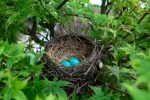What do you picture when you hear about bird’s nest? Is it bowl made of twigs in the middle of tree branches, and when you look inside of it you see baby birds, chirping, asking for worms? Well, you are correct. A bird nest is a spot for the bird to lay, incubate its eggs, and raise the young, mostly made of twigs or branches and located up in the tree. But, what exactly is the bird’s nest, what does it made of, and the main topic for today’s article:
How important the bird’s nest for its life?
Let’s educate ourself with a short brief about bird’s nest first. A nest is a place for the bird to rest, to lay eggs, incubate them, and a place to raise the young since the baby has not learned to fly yet.
The materials of the nest
The bird’s nest may be composed of several kinds of materials, which depend on the purposes. Usually, a simple nest one uses twigs for the base of the nest, with soft or fine grass to fill it up like a carpet. Some birds, for example, Robin birds who is also well known for its experience to build a nest, step up their game on building the nest by adding mud to the materials, combine in with leaves and twigs to weave and cementing their nest. Another example, let say, Baltimore oriole who has a hanging nest is also weaving and tying knots in long plant fibers for their nest.
Yes, birds nest doesn’t always have to be in the shape of chamber bowl-like. The structures are strongly influenced by topography and vegetation in their surrounding. Sometimes it can be in the form of the hanging nest like American oriole, some have knot-hole nest from the broken branch, some have their nest made of their dried saliva, a tunnel made of mud, or even only a burrow dug into the ground. Each of them is different and unique, with different types, complexities, and functions, just like the architectural design that we know for our buildings, right?
We can categorize the type of nest into 5 nests type:
- Cavity: the nest from a hollowed-out opening from the broken branch in the trunk of the tree. The birds who have this type of nest are chickadees and woodpeckers (who made the hole by their self)
- Cup: the most well-known bird’s nest, in the form of a cup or chamber-like, made of strong materials on the outside, and the softer one for the inside. The birds who have cup nest are songbirds such as sparrow or hummingbirds.
- Pendulum: Most of the nest with this type is made of mosses, small twigs, and lichens that are hanging in the tree branches, making the nest look like a hanging sac-like shape. For example, the oriole’s nest.
- Platform: The nest is flat and supported by limbs of the tree. Some of the bird species with this type of nest, especially the bird in the raptor group have their nest put in the very top of large dead trees. For example, crows’, hawk’s, and eagle’s nest.
- Spherical: The nest looks like a globe with an opening on one side, made of grasses. The birds who have this type of nest is Marsh Wrens and Cactus Wrens.
The builder
Do you know, most of the nest is made by the female? In the world of bird, sometimes the skilled builder one is the female. The female, sometimes not only collecting the materials but from choosing the best site until building the construction, but sometimes both parents or just the male will build it. Choosing the site is important because it can affect their breeding’s success.
The function and the importance
Not only to provide a safe place for eggs and young birds, but the nest can also have specific functions, including:


